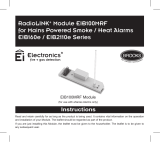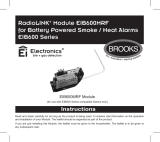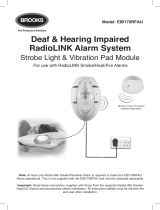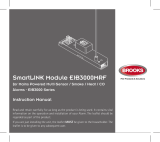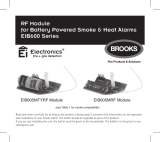Page is loading ...

RADIOLINK PANEL MODULE
Model: Ei413
RadioLINK Smoke Alarms & Accessories can be
connected wirelessly to Security & Fire Panels
• Powered by 11 - 30VDC from panel
• Can be mounted internally or externally to the panel
• Provides relay outputs (NC, C, NO) from
- Smoke Alarms sensing re
- Alarm fault (Low Battery or Contaminated Chamber)
- CO Alarm sensing CO
• Panel can trigger all smoke / CO alarms to sound
• Unique house coding feature
• Blue LED to facilitate house coding and visual RF transmission
indication
• RF performance to EN300 220-1 in accordance with EN300
220-2
• EMC performance to EN301 489-1 referencing EN301 489-3
• 5 year guarantee
1
House Code Switch
Blue Light
RF Indicator

Security Panel Installation
The Ei413 can be installed in or next to the panel. If the panel
is in a metal case, then the module should be located on the
outside of the panel.
CAUTION!
Before connecting the Ei413 to a re or security panel please
check with the panel manufacturer to determine the correct End
of Line (EOL) device(s) to use and how and where they should
be tted.
PANEL
FIRE RELAY
Alarm In
ANTENNA
NC
NO
C
NC
NO
C
Vin
SW
SW
}
RadioLINK
Alarms &
Controls
J1
NC
NO
C
CO RELAY
FAULT RELAY
Voltage Free
Contact Input
Voltage Free
Contact Input
Voltage Free
Contact Input
J1
Dry Contact
12V DC
C
NO
11-30VDC Supply
2
Security Panel Wiring Diagram

Check with the panel manufacturers installation manual for
wiring and termination details before proceeding:
1. Each relay of the Ei413 panel module, where used, is wired
to a corresponding contact input in the panel.
2. Check that the sliding jumper link J1 (yellow) is in the off
position. This is the factory default setting.
3. Locate the auxiliary power output in the panel and wire
it to the Vin connector on the Ei413 panel module, being
careful to ensure the polarity of the auxiliary power supply
has been wired correctly.
4. The “Alarm in” signal is optional and can be triggered by an
11 - 30V DC or a dry contact signal from the panel. When
this signal is activated the Ei413 will send out an RF Fire
signal which will activate any RadioLINK alarms or devices
that are in the same housecode.
Fire Panel Installation
CAUTION!
In this application the Fire and Fault relays are being congured
to allow the re panel to indicate a re or fault condition. The
wiring details and end of line (EOL) termination details will
change for different re panels so it is imperitive that you check
the panel manufacturers installation manual before proceeding.
Operation
1. When the Ei413 receives a re signal it will create a short
circuit across the Detector Zone Input, resulting in a re
indication on the panel. A current limiting resistor may be
required so check the panel manufacturers installation
manual.
2. When the Ei413 receives a fault signal it will open circuit
the connection to the Detector Zone Input, resulting in a
fault indication on the panel.
3. A re signal will override a fault signal .
Installation
1. Slide the jumper link J1 (yellow) to the on position. The
factory default setting is off.
2. Locate the auxiliary power output in the panel and wire it to
the Vin connector on the Ei413 panel module.
3. Check that the polarity of the auxiliary power supply has
been wired correctly.
4. Wire the Fault Relay common (C) terminal and the Fire
Relay common (C) terminal to a detector circuit in the
panel.
5. Wire the manufacturers End of Line (EOL) device according
to the re panel installation manual.
6. Power up the re panel and the Ei413 panel module and
follow the manufacturers instructions to set up the re
panel system.
3

House Code Procedure
After the system is installed and connected to the panel do the
following:
1. Press the house code switch through the narrow hole in the
case until the blue light turns on and then release.
2. Press the house code switch on all the other RadioLINK
devices to them in house code.
3. Check that the number of ashes from the units corresponds
to the number of devices / alarms in your system.
4. Remove all devices from house code by repeating step
1 above. Check the house code ashing indicators have
stopped on all units.
5. Button test each alarm to check your system.
6. Check the panel triggers with each alarm.
4
11-30VDC Supply
PANEL
FIRE RELAY
SW
SW
Alarm In
ANTENNA
NC
NO
C
NC
NO
C
Vin
}
Detector Zone Input
RadioLINK
Alarms &
Controls
J1
NC
NO
C
CO RELAY
FAULT RELAY
J1
C
NO
Dry Contact
24V DC
EOL
Device
Fire Panel Wiring Diagram

Technical Specication
Power Required: 12 V (range 11 to 30V)
Current Required: 15mA (Standby max.)
60mA (Alarm max.)
RF Range*: Over 100 metres in free space
RF Frequency: 868.499 MHz
RF Multi-repeater Function: The module acts as an RF
repeater to extend the range and reliability of the system.
Dimensions: 88mm X 88mm X 28mm
Weight: 125 grams
* Obstructions will result in a reduction on range from the free
space specication. The actual range will vary considerably
depending on installation.
Outputs to Panel: Fire Relay - NC, NO, Contacts rating 30V,
1 amp (NO contact closes when an alarm / test message is
received from a house coded smoke alarm or other device).
Fault Relay - NC, NO, Contacts rating 30V, 1 amp (NO contact
closes when a low battery or fault message is received from a
house coded smoke alarm or other device).
CO Relay - NC, NO, Contacts rating 30V, 1 amp (NO contact
closes when an alarm / test message is received from a house
coded CO alarm).
Note 1: after the fault condition has been cleared it will take up
to 5 hours for the relay to reset. The fault condition is cleared by
xing the fault but it is also cleared by receiving an alarm / test
message.
Inputs from Panel: Alarm:- Shorting the inputs of the SW terminals
will put all the smoke / CO alarms into alarm.When this short circuit
is removed it will send a “cancel alarm” message.
Alarm: - applying 11 - 30VDC to the ‘+’ and ‘- ‘ terminals will put all
the smoke / CO alarms into alarm. When this voltage is removed it
will send a “cancel alarm” message.
Temperature Range: 0ºC to 40ºC
Humidity Range: 15% to 95% Relative Humidity
(non-condensing)
5

Aico Ltd
Mile End Business Park,
Maesbury Road, Oswestry,
Shropshire SY10 8NN, U.K.
Telephone: 0870 7584000
www.aico.co.uk
Ei Electronics
Shannon Industrial Estate,
Shannon, Co. Clare, Ireland.
Telephone: +353 61 471277
www.eielectronics.com
P/N A17278 Rev 1
© Ei Electronics 2012
/

